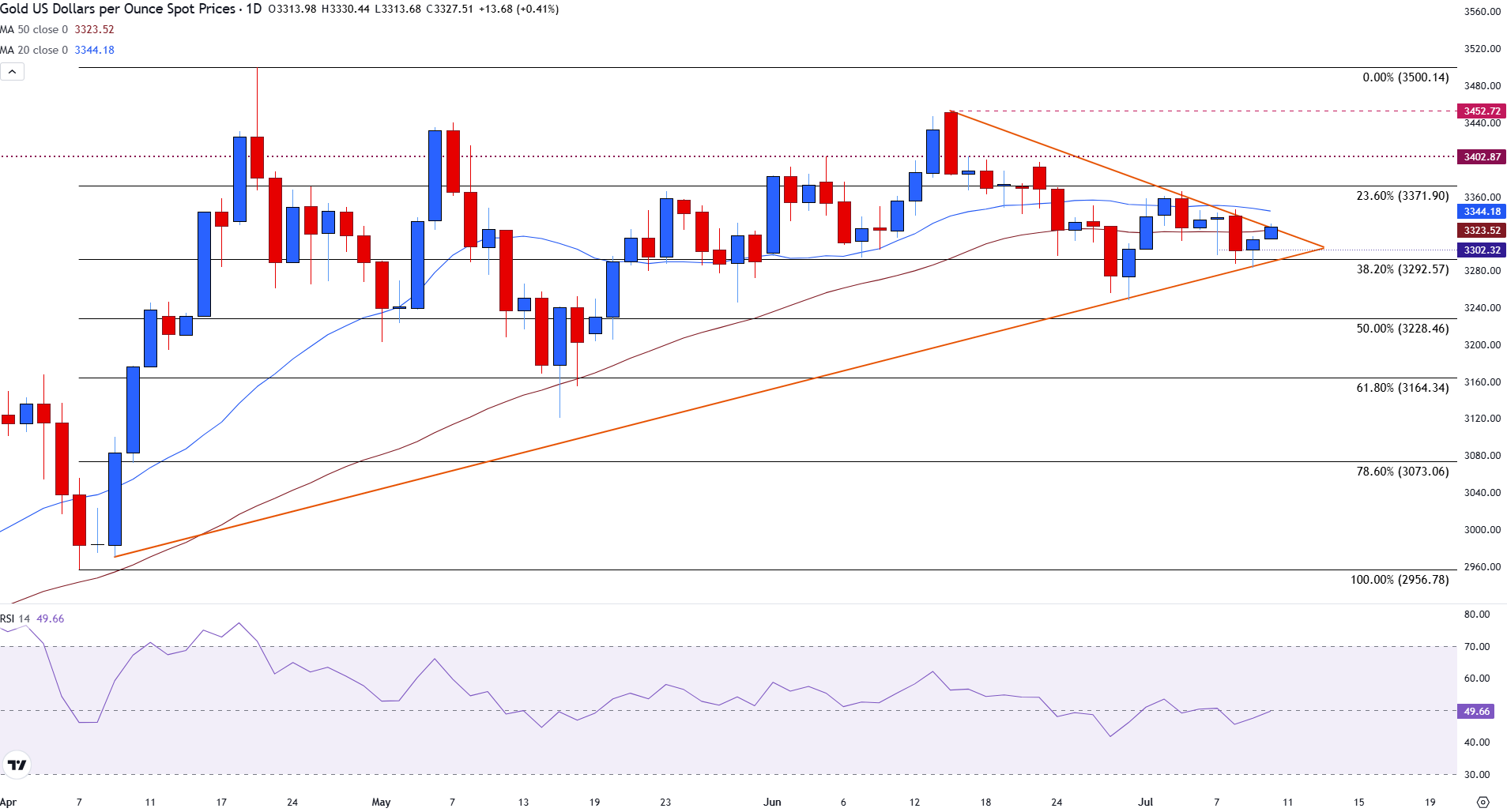Gold rises amid tariff threats, trade tension-driven safe-haven demand
- Gold price rises as tariff threats and trade tensions increase demand for the safe-haven bullion.
- Risk-off sentiment drives demand for the yellow metal, with lower US yields supporting gains.
- XAU/USD tests the upper bound of a symmetrical triangle pattern with resistance firming at $3,344.
Gold (XAU/USD) is ticking up slightly on Thursday, benefiting from escalating global trade tensions as recent tariff announcements from US President Trump have rekindled investors' appetite for bullion as a traditional safe-haven asset.
At the time of writing, XAU/USD is trading near $3,325, with persistent tariff threats – the latest targets were Brazil and Copper products – underpinning the Gold price in the short term.
Recent US Jobless Claims data continued to reflect a resilient labour market. This report, published by the US Department of Labor, measures the number of individuals filing new and continuing claims for state unemployment benefits and can provide insights about US employment trends.
Initial Jobless Claims printed at 227,000, down from 233,000 a week earlier, and Continuing Claims at 1.965 million, below the 1.98 million estimate. These figures are important labor market indicators given the Federal Reserve's data-dependent policy.
Daily Digest Market Movers: Gold climbs as Trump's tariffs trigger fresh safe-haven demand
- The minutes from the latest Federal Reserve policy meeting, released Wednesday, highlighted officials' concerns over persistent inflation risks stemming from tariffs. The minutes noted that "most participants noted the risk that tariffs could have more persistent effects on inflation," underscoring a cautious stance with a preference for clarity on economic outlook.
- Markets are currently assigning a 67.4% chance to a 25-basis-point interest rate cut by September, according to the CME FedWatch Tool. This year, the Fed has consistently held interest rates within a 4.25% to 4.50% range, supported by a resilient US labour market.
- Trade tensions have intensified after President Trump announced a significant 50% tariff on Copper imports, effective August 1, citing national security concerns. Trump declared via Truth Social, "America will, once again, build a DOMINANT Copper Industry." Brazil also faced fresh tariffs amid Trump's assertion that ongoing political proceedings against former Brazilian President Jair Bolsonaro are politically motivated. Further, Trump initiated a Section 301 investigation targeting Brazil’s digital trade policies.
- At a recent Cabinet meeting on Tuesday, Trump reinforced the firmness of the August 1 tariff implementation deadline, insisting, “Everybody has to pay. And the incentive is that they have the right to deal in the United States.” Additionally, Trump publicly criticized Fed Chair Jerome Powell, demanding his resignation via Truth Social and accusing him of politically motivated monetary policy: "Rates should have been cut months ago. The only reason they’re not is because Powell doesn’t want me to win.”
- Throughout the week, the US administration dispatched tariff-related letters to roughly 20 countries, including Japan and South Korea, outlining the fresh tariff rate.
Gold technical analysis: XAU/USD regains confidence above $3,300

Gold (XAU/USD) Daily chart
From a technical standpoint, Gold is testing the upper edge of a symmetrical triangle pattern, with the 20-day Simple Moving Average (SMA) currently providing resistance at $3,344.
At the time of writing, XAU/USD is hovering above the 50-day Simple Moving Average (SMA) at $3,323.
Key support lies at the psychological $3,300 mark and the 38.2% Fibonacci retracement level of April’s rally at $3,292. Additionally, the Relative Strength Index (RSI) hovering near neutral at 49 indicates indecision in the market. Meanwhile, immediate resistance is seen at the 20-day SMA of $3,344.
A decisive move below the crucial $3,300 level could open the door to additional downside pressure, targeting the 50% Fibonacci retracement zone and potentially further technical selling.
Risk sentiment FAQs
In the world of financial jargon the two widely used terms “risk-on” and “risk off'' refer to the level of risk that investors are willing to stomach during the period referenced. In a “risk-on” market, investors are optimistic about the future and more willing to buy risky assets. In a “risk-off” market investors start to ‘play it safe’ because they are worried about the future, and therefore buy less risky assets that are more certain of bringing a return, even if it is relatively modest.
Typically, during periods of “risk-on”, stock markets will rise, most commodities – except Gold – will also gain in value, since they benefit from a positive growth outlook. The currencies of nations that are heavy commodity exporters strengthen because of increased demand, and Cryptocurrencies rise. In a “risk-off” market, Bonds go up – especially major government Bonds – Gold shines, and safe-haven currencies such as the Japanese Yen, Swiss Franc and US Dollar all benefit.
The Australian Dollar (AUD), the Canadian Dollar (CAD), the New Zealand Dollar (NZD) and minor FX like the Ruble (RUB) and the South African Rand (ZAR), all tend to rise in markets that are “risk-on”. This is because the economies of these currencies are heavily reliant on commodity exports for growth, and commodities tend to rise in price during risk-on periods. This is because investors foresee greater demand for raw materials in the future due to heightened economic activity.
The major currencies that tend to rise during periods of “risk-off” are the US Dollar (USD), the Japanese Yen (JPY) and the Swiss Franc (CHF). The US Dollar, because it is the world’s reserve currency, and because in times of crisis investors buy US government debt, which is seen as safe because the largest economy in the world is unlikely to default. The Yen, from increased demand for Japanese government bonds, because a high proportion are held by domestic investors who are unlikely to dump them – even in a crisis. The Swiss Franc, because strict Swiss banking laws offer investors enhanced capital protection.